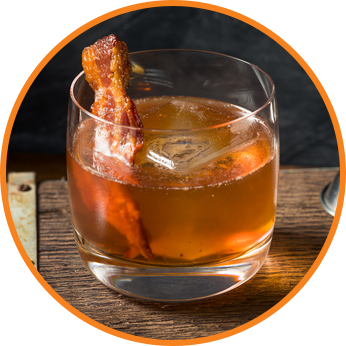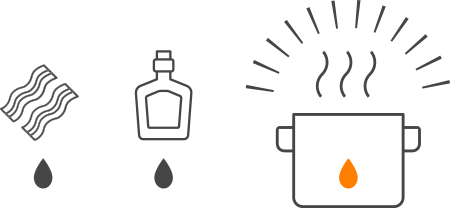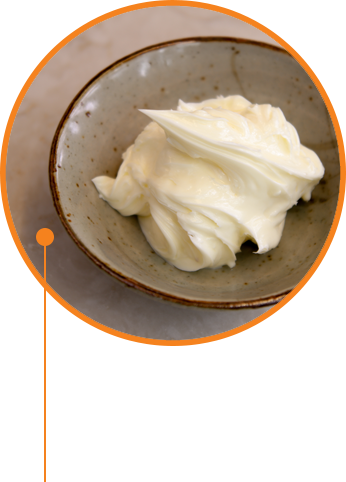Make a flavor-infused brown butter
In a pan over low heat, cook butter, ginger and garlic together until the butter is richly browned.
It all began with bacon. Back in the mid-2000s, when bacon-infused everything was the flavor trend of the moment, mixologists began experimenting with ways to make bacon-flavored cocktails.
At the New York craft cocktail bar Please Don’t Tell, bartender Don Lee created the Benton’s Old Fashioned, a Bourbon Old-Fashioned, flavored with maple syrup and infused with the flavor of bacon. To make it, Lee drew inspiration from an old perfume-making technique known as enfleurage, in which delicate aromatic components are extracted from flowers and plants by first steeping them in rendered animal fat, and then “washing” the fat with alcohol, so that the aromas would be transferred to the alcohol.


Lee’s version of the technique involved steeping rendered bacon fat with Bourbon, chilling the mixture, and then straining off the fat, leaving the spirit infused with the flavor of bacon and a richer, silkier mouthfeel from the residual fat. The Benton’s Old-Fashioned quickly became the bar’s most popular cocktail, and the technique, known as “fat-washing,” took off in mixology circles. Soon, creative bartenders were coming up with cocktails infused with the flavors of other fats, like butter, brown butter, sesame oil, coconut oil, duck fat, chorizo, and peanut butter.
Meanwhile, some chefs were beginning to explore creative ways to fat-wash flavor and richness into culinary applications.
At Jimoto Ya, an artisan ramen shop in Singapore, owner Sean McCully came up with a version of the restaurant’s signature Ebi (shrimp) Ramen that’s served with a shot of premium Japanese single-malt whiskey that has been fat-washed with shrimp oil. Stirred into the broth at the table, the whiskey doesn’t simply intensify the shrimp flavor of the dish, it also adds a mouthcoating richness and smoky finish to the dish.

Butter softens soy sauce’s mouthfeel and flavor
Kikkoman Sales USA Executive Chef and culinology guru Andrew Hunter has also been working on culinary applications for fat-washing.
“I was inspired by a mixologist friend who blends melted butter into bourbon, then freezes it so the butter rises to the top,” says Chef Hunter. “After he removes the butter cap, the resulting bourbon is silkier in flavor and mouthfeel. I wondered if fat washing our soy sauce and ponzu with butter would have a similar effect. And what I discovered was that, just like it does to bourbon, the butter softens soy sauce’s mouthfeel and flavor. The more butter you add the silkier the soy sauce.”
Chef Hunter began experimenting with ways to infuse Soy Sauce and Ponzu (a citrus-infused soy sauce) with flavorful fats. He devised a method that involves melting and infusing fat with flavorful ingredients, then warming and steeping the fat with Kikkoman® Soy Sauce or Ponzu to meld the flavors. He uses a blender to fuse the flavors together, then chills the mixture to solidify the fat, and strains off the fat-washed sauce.
Chef Hunter explains that “an added benefit of fat-washing soy sauce is that you end up with three ingredients: the fat-washed soy, soy infused butter, and a combination of both for a really delicious soy-butter sauce. In addition to acting as the flavor foundation,” he explains, “the butter also contributes a savory note and velvety mouthfeel. Infusing fresh herbs and spices, like fresh ginger and garlic in the toasted butter can help build layers of flavor into a dish.

In a pan over low heat, cook butter, ginger and garlic together until the butter is richly browned.
Gently heat Kikkoman® Citrus Seasoned Ponzu to ~140°F. Don’t exceed 160°F because if steam is created, the fresh citrus notes will be diminished.
Add the infused butter to the warm ponzu and hold warm for several minutes to meld the flavors together.
Strain the garlic and ginger out. Then transfer the sauce to a running blender to further meld the flavors on a molecular level.
Chill the sauce until the butter rises to the top and forms a solid raft.
Bore a hole through the butter raft, pour off the fat-washed Ponzu, and strain it to remove residual bits of fat. Reserve both the fat-washed Ponzu and the butter for cooking.
Use the fat-washed Ponzu at room temperature as a condiment for dumplings, such as Shao Mai Potstickers.
First, let’s talk about the brown butter. The Maillard reaction is a chemical reaction between an amino acid and carbohydrates under high heat. It’s what makes steak brown when you are grilling, it’s what gives soy sauce its color, and it’s what produces the color and flavor compounds that you see, taste and smell when browning butter.
But how is the brown butter interacting with the Ponzu? We all know that water and oil don’t mix. This is because of a concept called polarity, which refers to the way atoms of a molecule bond with each other. Oil is non-polar (in other words, not water soluble) while water is polar.
But there are water-soluble and fat-soluble flavor and aroma compounds in both the butter and the Ponzu that can form chemical interactions based on polarity. This allows for a change in flavor profile in the finished product, in which the Ponzu retains some butter attributes.
Additionally, when you strain out the butter after fat-washing, it is impossible to remove 100% of the fat, even if you refrigerate or freeze the mixture. The small amount of residual fat contributes noticeably to the tongue-coating mouthfeel of the fat-washed sauce.


Hunter encourages chefs to experiment with soy sauce and ponzu fat-washing techniques and applications. “You can use different types of fat including duck or chicken fat” he says. “You can also add a small percentage of toasted sesame oil or olive oil to the butter. But for food-chemistry reasons, straight oil doesn’t have nearly the same impact.”
In addition to serving fat-washed Ponzu or Soy Sauce as a condiment and dipping sauce, Hunter suggests two other ideas and encourages chefs to “pretend your kitchen is a science lab and try as many combinations as you can think of!”
Ponzu Beurre Vert
Make a “Beurre Vert” or green butter sauce by mounting fat-washed Ponzu with butter. Finish with fresh tarragon leaves and ginger.
Fat-Washed Teriyaki
Make a teriyaki sauce using fat-washed Ponzu, brown sugar, and candied ginger.